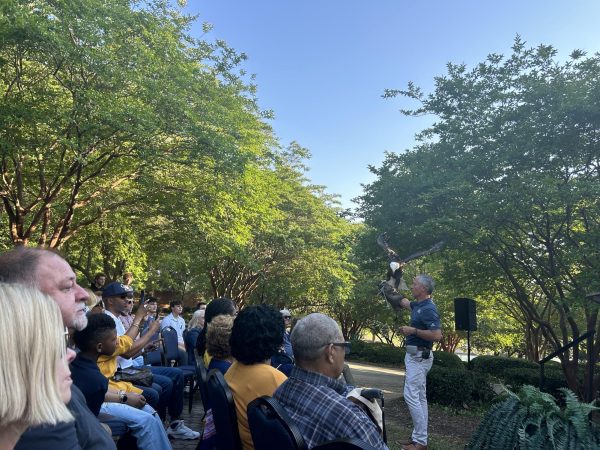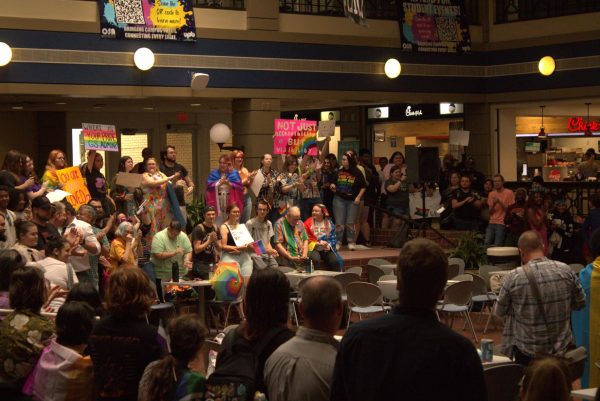ITS increases bandwidth
January 28, 2014
Students will now be able to browse the Internet faster during the busiest parts of the day on campus with the addition of a second fiber optic cable, increasing the bandwidth and Internet connectivity.
Information Technology Services (ITS) made improvements to the campus bandwidth by adding a second fiber optic cable, meaning better Internet connectivity and reliability for students.
“If there was a break beyond Georgia Southern campus, then that second connection automatically takes over and we won’t lose connectivity with the rest of the world,” Steve Burrell, vice president of Information Technology and chief information officer, said.
A full gigabyte of bandwidth was added for campus and another gigabyte for residence halls, more than doubling the bandwidth available.
The maximum download speed per user has now increased to 8 Mbps and will eventually reach up to 10 Mbps, Burrell said.
Overall speed will depend on many factors, like the speed of the computer, how many things a user is doing at once and the speed of the network a user is connected to, Burrell said.
The new fiber optic cable connects GSU to PeachNet and was established and tested on Dec. 21 of last year. Students may remember when the Internet was down throughout campus the evening of Nov. 4, 2013 and into the next morning. The addition of this cable will aid in preventing such incidents from happening in the future.
Service has greatly improved, however wireless signal strength may not have truly improved. That depends on location, Burrell said.
Southern Pines and Southern Courtyard have recently had an update in their wireless connection. They were the last of the residence halls to be updated. The upgrade was delayed until the bandwidth was increased as a preventive measure against exacerbating the problem.
“Sometimes I’ll log on and ResNet won’t even show up as an option. Other times there’s no problem. My friend in Southern Courtyard finally got Wi-Fi and his connection is faster than mine is at home,” Abbie Pelech, freshman engineering major, said.
“I couldn’t even use my phone in my room because there wasn’t a connection. Now it actually works,” Brittany Railing, freshman early childhood education major and Southern Pines resident, said.
Students connecting to Wi-Fi anywhere on campus instead of a campus computer are still advised to use a category five or six Ethernet cord and physically plug into an outlet, especially if connection speed is necessary for an activity such as online gaming or streaming movies.
Both of those cords are most used in cases where the user relies on an Ethernet connection. Students in residence halls electing to use a cord to improve connection and speed can call ResNet. They will be given a cord and shown how to use it.
“Wireless is subject to how many people are in your area and it’s also a shared medium so a lot of people can be tapped into it at once and hurting your connectivity,” Burrell said.
GSU contributed $325,000 to upgrading the network. The University System of Georgia spent a larger amount on the upgrades and construction of the second fiber optic cable.
“We used a lease mechanism to get things rolling. That deferred the need to pay for every little thing up front,” Burrell said.
Within the next few months, ITS plans to increase the bandwidth another eight gigabytes, for a total of ten gigabytes, in order to create a research network database for faculty research.
The research network is still conceptual and no specifics have been planned out yet.
Students living off-campus are not affected by the changes but are encouraged to use resources on campus.
“They’d have to talk to their landlord or service provider, whoever it may be. Some of the apartments have only one connection going out. If they have issues, my advice is we have a great library. Use those resources,” Burrell said.
Google will be releasing a product eventually that uses less bandwidth but provides a better quality image when streaming videos on sites like YouTube and Netflix, Burrell said.
The prioritization that was implemented last year will still continue whenever utilization exceeds the available bandwidth. However, that has not happened since the upgrade, Burrell said.














